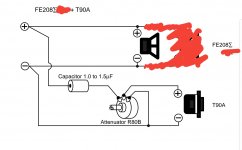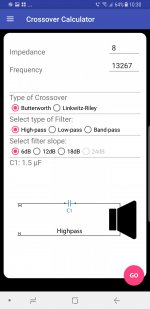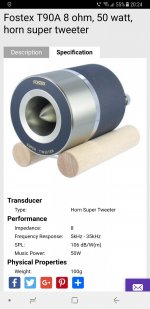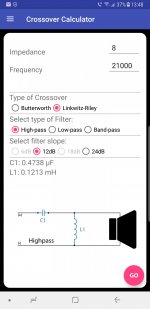Hi guys. I've ordered some cheap caps so that I can test before investing in some really decent ones, but I've been looking at the crossover frequency for the 2 different cap ratings Fostex recommend and I can't work out why they've recommended them as it makes the crossover point very high indeed....although i know it's a super-tweeter, it doesn't make sense to me given a) the lower end frequency capability of the T90a super-tweeter (5khz) and b) the range of human hearing (especially my 40 year old ears). Can anyone help me understand? Images attached to support my confusion (apologies.... I'm still new to all this! )...
Attachments
You should use at min. 12 dB/oct. filter.
Sorry mate, I don't know what you mean, I'm still new to this. I will have the fostex R80b attenuator too, what would I need to do to make this setup a 12db/oct filter?
Thanks - Wayne.
You will want to turn on/try capacitor <1uF (0.47uF say).
Read posts from # 44 to # 49 in this thread:
Belden DIY audio cables
Read posts from # 44 to # 49 in this thread:
Belden DIY audio cables
For the low pass:
coil and capacitor
For the high pass:
capacitor and coil
Sorry, I still don't know what you mean, but aren't you suggesting something different to what Fostex are recommending (my first attached image)? They are showing no coils or caps for the full range driver, and an attenuator and capacitor for the super tweeter...
Last edited:
You will want to turn on/try capacitor <1uF (0.47uF say).
Read posts from # 44 to # 49 in this thread:
Belden DIY audio cables
Thank you, but wouldn't that capacitor make the crossover point 42khz?! See attached...
Attachments
I can't work out why they've recommended them as it makes the crossover point very high indeed....
Just try it and take the super tweeter in and out of circuit. There is a bit of a religion among fullrange addicts, one where they desire a supertweeter but cross it over above audibility. The low 6dB rolloff assures that some of the tweeter output will be audible.
I have found this read post 10
Thank you. Is that this kind of crossover instead?
a tweeter needed for FE 208E Sigma in a BIB enclosure
Attachments
Just try it and take the super tweeter in and out of circuit. There is a bit of a religion among fullrange addicts, one where they desire a supertweeter but cross it over above audibility. The low 6dB rolloff assures that some of the tweeter output will be audible.
Thanks Ron. P.s. I'm building a Dallas II for these drivers.
A second order crossover would be recommended if you were trying to make a two way or cross over below 6kHz or so. Try using the recommended caps first.
Thanks for understanding my lack of experience, Ron
Can you post the datasheets or datasheet links of both drivers?
Sure...
https://www.fostexinternational.com/docs/speaker_components/pdf/fe208ez.pdf
https://www.fostexinternational.com/docs/speaker_components/pdf/t90arev.pdf
The problem is, that the datasheet of the horn tweeter does not show the resonance frequency.
I would not use the attenuator, but an voltage divider.
I don't mean this to sound rude, but why are all of your suggestions against the manufacturers recommendations? I acknowledge that you clearly know a lot about all this, but to my novice mind, it's almost as if you're trying to find a solution to a problem which doesn't exist?
In this particular example, why not use the attenuator?
Thanks.
- Status
- This old topic is closed. If you want to reopen this topic, contact a moderator using the "Report Post" button.
- Home
- Loudspeakers
- Multi-Way
- Passive Crossover for Fostex 208ez and T90A





